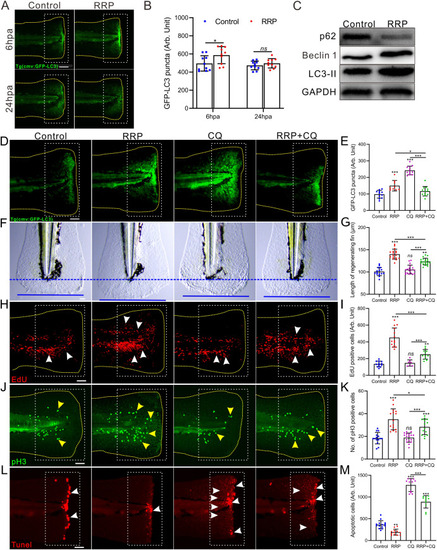Fig. 2
- ID
- ZDB-FIG-240618-39
- Publication
- Chen et al., 2024 - Radix Rehmanniae Praeparata promoted zebrafish fin regeneration through aryl hydrocarbon receptor-dependent autophagy
- Other Figures
- All Figure Page
- Back to All Figure Page
|
RRP stimulated autophagy during zebrafish caudal fin regeneration. A. Representative images showing the autophagy puncta (green fluorescence) at the injured site in fin of Tg (cmv: GFP-LC3) zebrafish. Scale bar: 200 μm. B. The bar chart showing the statistical result in panel A, n = 10. C. Western blotting images to show the relative expression levels of autophagy related proteins in different regimens at 6 hpa. D. Representative images showing the autophagy puncta (green fluorescence) at the injured site in fin of Tg (cmv: GFP-LC3) zebrafish in different regimens. Scale bar: 200 μm. E. The bar chart showing the statistical result in panel D, n = 9∼12. F. Representative images showing the length of regenerating fin at 2 dpa in different regimens. Blue dashed lines indicate the initial cutting site of the fin, and the blue lines indicate the end of the regenerating fin at 2 dpa. The distance between the blue dashed line and the blue line represents the length of the fin regenerated. Scale bar: 100 μm. G. Bar chart showing the quantitative results in panel F, n = 15∼20. H-M. Representative images showing proliferating cells at S-phage (H, red dot, white arrow), mitotic cells at M-phage (J, green dot, yellow arrow), and apoptotic cells (L, red dot, white arrow) in the wound of 1 dpa, 2 dpa, and 6 hpa zebrafish larvae with different regimens, respectively. Scale bar: 200 μm. Bar chart of I, K, and M showing the quantitative results in panel H (n = 7∼14), J (n = 14∼16), and L (n = 11∼15), respectively. The yellow dashed line in each panel displays the shape of the tail in A, D, H and J. The white dotted boxes represent the statistical areas. Data were expressed as mean ± S.D., and statistical results were analyzed by Unpaired two tail t-test (B) and one-way ANOVA with Tukey's post hoc test (E, G, I, K, M). Asterisk in panel B, E, G, I, K, and M represent the significant difference observed when compared with the other group at p < 0.05 (*), p < 0.01 (**) or p < 0.001 (***) level. |

